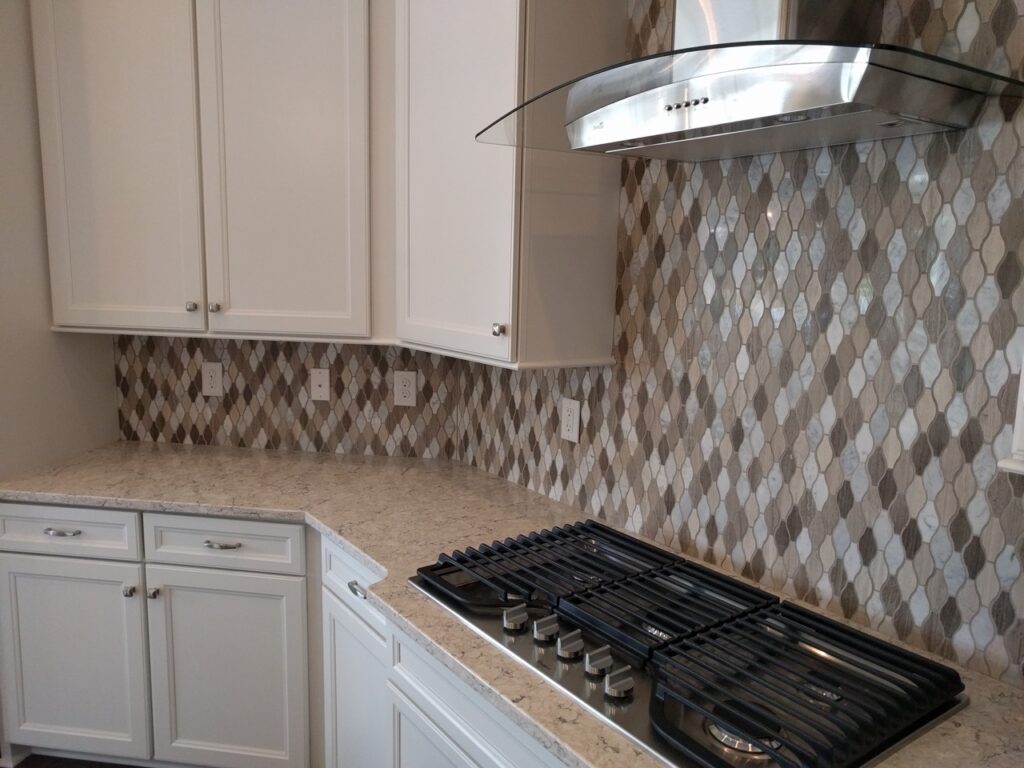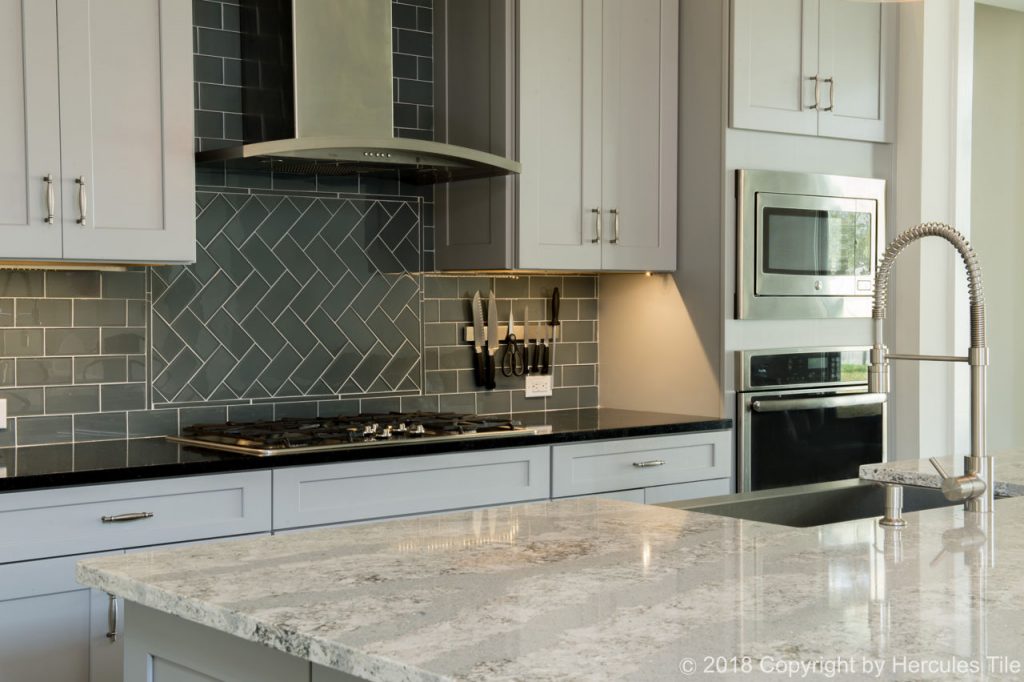Introduction to Kitchen backsplash design
The kitchen is often referred to as the heart of the home, and its design speaks volumes about the homeowner’s style and the home’s overall ambiance. Among the myriad of design choices, the kitchen backsplash stands out not only for its functional role but also for its significant impact on the kitchen’s aesthetic appeal. A well-chosen backsplash can transform a mundane kitchen into a masterpiece of interior design.
This post delves into the importance of kitchen backsplashes, explores the variety of options available, and highlights key considerations when choosing the perfect backsplash for your kitchen.
The Role of Kitchen Backsplash Tiles
Practical Purposes of a Tile Backsplash
The primary function of a kitchen backsplash is to protect the wall behind the countertop from splashes, stains, and heat. This protective barrier makes cleaning easier and prevents damage that can be caused by cooking activities. Without a backsplash, walls can become stained or damaged over time, leading to a kitchen that looks worn and neglected.
Aesthetic Impact of Kitchen backsplash tile
Beyond its practical role, the kitchen backsplash plays a crucial role in defining the kitchen’s design theme. It can serve as a focal point or complement the overall design aesthetic, whether modern, traditional, or eclectic.
The right backsplash can tie together all elements of the kitchen, creating a cohesive and visually appealing space. A beautiful mosaic tile backsplash can add visual interest to any kitchen and complement both a neutral color palette and bolder wall tiles or cabinets and countertops.

Comprehensive Guide to Kitchen Backsplash Materials
Ceramic Backsplash Tile
- Pros and Cons: Ceramic tiles are praised for their versatility, durability, and wide range of designs. However, grout lines may require regular maintenance to prevent staining.
- Variety: Available in an endless array of colors, shapes, and sizes, ceramic tiles offer endless possibilities for customization.
Glass Backsplash Tile
- Benefits: Glass tiles reflect light, brightening the kitchen and making it appear larger. They come in various colors and finishes, allowing for creative designs. Glass mosaic tiles are still very popular.
- Installation and Cleaning Tips: Glass tiles are relatively easy to install but require careful handling to avoid chips. They are easy to clean with a simple wipe-down.
Natural Stone Backsplash
- Types: Marble, granite, and slate are popular choices, each adding a unique texture and elegance to the kitchen.
- Sealing and Maintenance: Natural stone requires sealing to prevent stains and may need regular maintenance to keep it looking pristine.
Porcelain Backsplash Tile
- Durability and Design Versatility: Porcelain tiles are highly durable and resistant to wear and tear, making them suitable for high-traffic kitchens. They also offer a wide range of design options.
- Comparison with Ceramic Tile: Porcelain tiles are denser and less porous than ceramic tiles, making them more resistant to moisture and stains.
Stainless Steel/Metal Backsplash
- Modern Look and Easy Maintenance: Metal backsplashes provide a sleek, modern look and are easy to clean, making them ideal for contemporary kitchens.
- Considerations for Installation: Metal backsplashes can be more challenging to install and may require professional help, especially for custom designs.
Peel-and-Stick Options
- Cost-effectiveness and DIY-friendly: Peel-and-stick tiles offer an affordable and easy-to-install option for homeowners looking to update their backsplash without a significant investment.
- Limitations and Durability Concerns: While convenient, peel-and-stick tiles may not be as durable as other materials and might not withstand high heat or moisture levels.
Unique Materials as a Backsplash
- Wood, Cork, and Mirror: These materials offer unique textures and looks for more creative or unconventional kitchen designs. They may require special care and maintenance to preserve their appearance and functionality.
Backsplash tile ideas
Choosing the right kitchen backsplash involves balancing functionality with aesthetics. Whether you prefer the durability and versatility of ceramic or porcelain tiles, the elegance of natural stone, the sleekness of metal, or the innovation of peel-and-stick options, there’s a material that fits every kitchen’s needs and style.
By considering the practical aspects of maintenance and installation, as well as the design impact of your chosen material, you can select a backsplash that not only protects your kitchen walls but also elevates the entire space. Remember, the perfect backsplash is the one that reflects your style while enhancing the functionality and beauty of your kitchen.

FAQs in Choosing a Kitchen Backsplash & Kitchen Backsplash Ideas
When embarking on the journey to select the perfect kitchen backsplash, homeowners are met with a myriad of questions and considerations. From durability and maintenance to installation complexities and style choices, the decision-making process can feel overwhelming.
In this section, we delve into the Frequently Asked Questions (FAQs) surrounding the selection of a kitchen backsplash.
What is the best type of backsplash for a kitchen?
The best type of backsplash is one that balances functionality with aesthetic appeal. Ceramic and porcelain tiles are highly regarded for their durability, ease of cleaning, and wide range of designs.
What is the rule for kitchen backsplash?
There’s no one-size-fits-all rule, but a common guideline is to choose a backsplash that complements both the countertops and cabinetry, creating a cohesive look. Ensure it’s durable and easy to clean, especially in cooking areas.
What is the easiest kitchen backsplash to install?
Peel-and-stick tiles are the easiest to install, as they require no mortar or grout and can be applied directly to a clean, smooth surface.
What is the easiest backsplash to clean behind a range?
Glass tiles and stainless steel are among the easiest to clean, as they offer smooth surfaces that don’t hold onto grease and stains. A simple wipe-down with a damp cloth can keep them looking new.
What is the best backsplash for a kitchen?
The best backsplash is subjective and depends on personal preference. However, materials like porcelain and ceramic tile are popular for their versatility, durability, and ease of maintenance.
What is the most popular backsplash for a kitchen?
Subway tiles have remained a popular choice for their classic look and versatility. A classic subway tile backsplash can fit into various kitchen styles, from traditional to modern.
A mosaic tile backsplash is another very sought-after design choice.
What is the best choice for a kitchen backsplash?
The best choice is a material that reflects your style, is within your budget, and meets your durability and maintenance requirements.
Ceramic, porcelain, and glass tiles are often recommended for their balance of these factors.
Should a kitchen backsplash be lighter or darker than the countertop?
This depends on personal preference and the desired visual effect. A lighter backsplash can brighten a kitchen, while a darker one can create contrast. Ensure the colors complement each other for a cohesive design.
What is the best tile for a backsplash?
Ceramic and porcelain tiles are considered the best for their durability, ease of maintenance, and wide range of design options.
Do peel-and-stick backsplash tiles come off?
Yes, peel-and-stick tiles can be removed, making them a flexible option for renters or those looking for a temporary change. Their lifespan may be shorter than traditional tile backsplashes, especially in high-moisture or high-heat areas. However, frequent removal and reapplication can reduce their adhesive strength. They’re best for areas with minimal moisture and can provide a temporary or semi-permanent solution.
Does backsplash tile go on drywall?
Yes, backsplash tiles can be installed on drywall, provided the drywall is clean, smooth, and properly prepared. It’s crucial to ensure the drywall is in good condition to support the weight of the tiles.
What type of tile is best for a kitchen backsplash?
Ceramic and porcelain tiles are ideal for kitchen backsplashes due to their durability, ease of cleaning, and wide range of styles.
In summary, the best kitchen backsplash choice depends on your specific needs, preferences, and the overall design of your kitchen. Factors like durability, ease of cleaning, installation, and aesthetic appeal should guide your decision.
